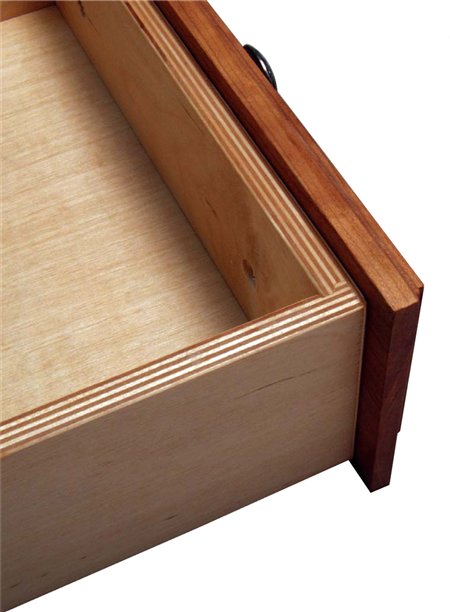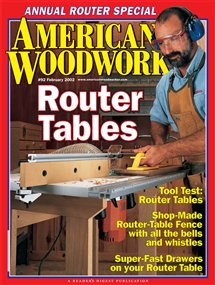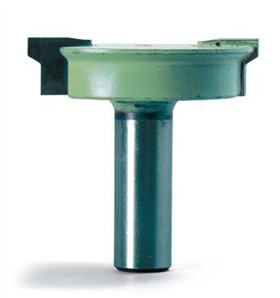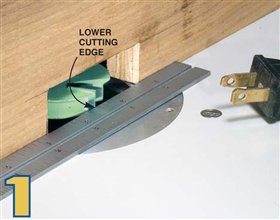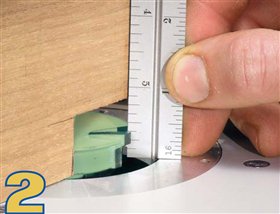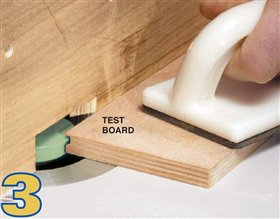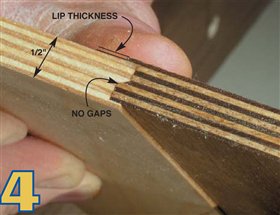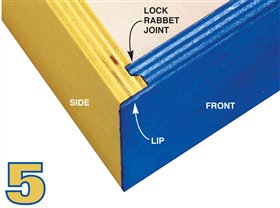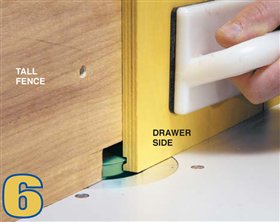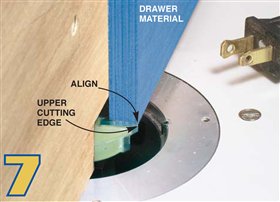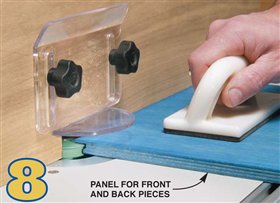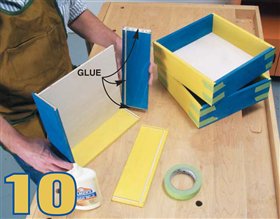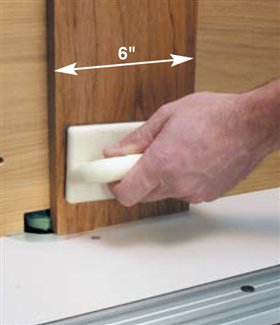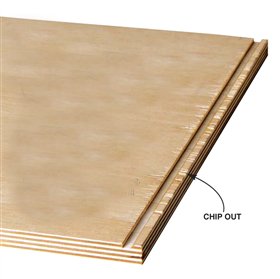For fast, easy, accurate joinery in everything from
kitchen-cabinet drawers to jewelry boxes, the lock
rabbet is the way to go. Lock rabbets are self-aligning
and sufficiently strong for light- and medium-duty
drawers.
As with most woodworking techniques, there is more
than one way to make a lock rabbet.We experimented
with several methods using the tablesaw and router
table and settled on this as our favorite. It uses a router
bit called a drawer lock bit (see Sources, below).
And for the wood,we chose 1/2-in.Baltic birch plywood.
Its multiple layers and lack of internal
voids make it strong and stable.
Router bit setup
Setting up the drawer lock bit is not difficult.
Start by aligning this bit with the fence, as
shown in Photo 1. Next, adjust the height of
the bit to approximately 3/8 in. (Photo 2).Run
a couple of test boards (Photo 3) and check the
fit (Photo 4).The first test boards you make are
unlikely to give you a perfect fit, so adjust the bit’s
height until the fit is just right.
Making the drawer sides
To determine the length of your drawer sides, subtract two
times the thickness of the lip on your test board (Photo 4)
from your final drawer box length. For example, if you’re
making a 12-in.-long drawer box and the lip on the test
board is 1/16 in., the material for the drawer sides should
be 11-7/8-in. long.Here’s the math:
1/16″ x 2 = 1/8″
12″ – 1/8″ = 11-7/8″
Prepare your plywood by cutting it into panels that
equal the length you calculated with the formula above
and are two to three drawer-sides wide (Photo 9). Add
1 in. to the width to allow for saw kerfs and edge waste.
The edge waste will accommodate the chip-out that usually
occurs when the router bit exits the cut. To rout the
joint for drawer sides,hold the panel vertically against the
fence (Photo 6).
Making the drawer box fronts and backs
Reset your router-table fence before you rout the fronts
and backs. Set a scrap piece of your drawer-box material
on top of the bit and move the fence back until the cutting
depth matches the thickness of the material (Photo 7).
Run a test cut with a scrap of drawer-box material and
check the fit with the drawer side panels you cut earlier.
It should look like the joint in Photo 5. If the lip doesn’t
flush up with the side panel, readjust the router-table
fence and run another test cut until the lip is flush with
the side.
The drawer fronts and backs should be as long as the
final width of the drawer box because they span the full
width (Photo 5).These front and back panels are routed
flat on the table (Photo 8).
Final sizing
Now you can saw the drawer parts to final width (Photo 9).
Then, saw or rout a 3/16-in.-deep dado in the parts for the
drawer bottoms. Make the drawer bottoms out of 1/4-in.
plywood and test fit all the parts by assembling a drawer
without glue.
Assembling the drawer boxes
On small drawers,masking tape works fine as a clamping tool
(Photo 10). For larger drawers or thicker material, a few
small brads or metal clamps work well. Apply glue to
the joints and the dado for the bottom.By gluing the plywood
bottom in place, the drawer ends up considerably stronger.
Sources
(Note: Product availability and costs are subject to change since original publication date.)
The Hardwood Store of North Carolina, hardwoodstore.com, 888-445-7335, 1/2-in. Baltic Birch, 5 ft. x 5 ft.
The following companies sell drawer lock router bits. Prices average about
$32 for 1/4-in.-shank bits and $43 for 1/2-in.-shank bits.
Amana, 800-445-007.
Bosch, 877-267-2499.
CMT, 888-268-2487.
Craftsman, 800-377-7414.
Eagle America, 800-872-2511.
Freud, 800-334-4107.
Jesada, 800-531-5559.
Katana, 800-533-9298.
MLCS, 800-533-9298.
Oldham Viper, 800-828-9000.
Rockler, 800-279-4441.
Whiteside, 800-225-3982.
Woodline, 800-472-6950.
Woodworker’s Choice, 800-892-4866.
This story originally appeared in American Woodworker February 2002, issue #92.

Purchase this back issue. |
|
Click any image to view a larger version.

Use a drawer lock router bit on
drawer sides from 1/2- to 1-in. thick.

1. Adjust the router fence until the lower cutting edge just
touches the straightedge, which is tight against the fence.
Be sure your machine is unplugged during this adjustment.

2. Adjust the height of the router bit to approximately 3/8 in.
above the table.This is not the final setting, but a starting point.
Be sure your machine is unplugged during this adjustment.

3. Test the setup by routing a couple of scrap boards.

4. Check the fit. The test joints should fit together easily, but
without any gaps. Remember: Lower to loosen and heighten to
tighten. Lip thickness will be between 1/16 in. and 1/8 in. when
using 1/2-in. material.

5. Make both cuts for a lock rabbet joint with one router bit.
To clarify the process,we’ve colored the sides yellow and the
front and back blue.

6. Rout the panels for the drawer sides. Keep even pressure
on the panel so it stays against the fence and in constant
contact with the table. Use a tall fence for good support.

7. Reset the fence for fronts and backs using a scrap piece of
drawer-box material. Move the fence back so the upper cutting
edge aligns with the outer edge of the material.
Be sure your machine is unplugged during this adjustment.

8. Rout the front and back panels. Hold the panel firmly against
the table to prevent it from lifting, or you’ll spoil the joint.

9. Rip the drawer parts to final width and then saw or rout
the dado for the drawer bottoms.

10. Hold the parts of smaller drawers together with masking
tape. Be sure the boxes are square before setting them aside
to dry.
What about solid
or thick wood?

A drawer lock router bit
works equally well in solid
wood.However, it’s not safe
to rout anything narrower
than 6-in. wide with this
technique. For narrower
parts, start with a wider
board and rip the parts to
final width like we did with
the plywood.
The bit we used is good for
material from 1/2- to 1-in. thick.With thicker material, the
settings for the router bit and fence are determined just as
they were for our 1/2-in. Baltic birch.You’ll notice that if you
use thicker material, the lip will also be thicker.
Oops!

We fed this side panel
too fast and got lots of
chipping. By slowing down
the feed rate we were able
to keep this from happening.
A zero-clearance fence will
work wonders, too. |



